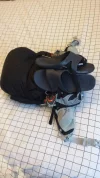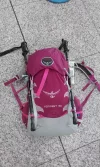You cannot know for certain until and unless you test-pack the 34-liter bag will all the gear you plan to carry. If you have relatively smaller clothing (and XXL or XL is certainly larger in volume and weight than an S or M) this makes a difference. The other difference is the amount of stuff you plan to take.
Secondly, consider the issue of "dangly bits." This is stuff that rides on the outside of your rucksack. You either attach stuff directory or tie a sack to the top or bottom of your rucksack, or clip items to the outside of your rucksack, or stuff in the stretchy pockets that most rucksacks now come with.
Some packs, like my Osprey Kestrel 48 liter have top lashing points that I use for ready access to raingear or fleece layers. I can reach back and pull the rolled up items from under the bungee cord shoelaces I use to hold these lightweight items in place.
This was cheap, light and color coordinated too. Buy the stretchy shoelaces at most running or outdoor stores. You can get longer hanks of stretchy cord for tent support purposes. But the bungee shoelaces were more elegant, at least to me.
My Kestrel 48 also has sleeping pad / bag straps incorporated to the bottom of the bag. This is where my lightweight sleeping bag and extra fleece layer ride in a waterproof Sea to Summit roll-top Wet Bag. The 8-liter size seems to work best for me. The sleeping bag is stuffed in first without using a compression bag and the fleece follows. If I do not need the sleeping bag, this becomes my pillow for the night. For a shorter Camino, the sleeping bag rides inside the rucksack's designated bottom sleeping bag pocket. The extra fleece is rolled up and rides on the top.
Third, and lastly, consider if you will carry items in a separate, accessory chest, waist or shoulder pack. I have seen many people wearing a rucksack over a shoulder bag strapped across their chest. It is a highly personal choice.
My only recommendation regarding these separate, usually special purpose carry bags, is to NEVER carry a bag that broadcasts what is in the bag. For example, if you have an expensive digital SLR camera or a video camera, DO NOT carry it in a camera case the screams "expensive camera" inside. Instead, I suggest you obtain an unbranded or generically branded case that will not be recognized as a camera case but will protect your camera.
Here is my reason. I served as an Amigo at Sanitago for two weeks last year (2014). On a daily basis people reported stolen cameras. Many of these people, when asked (I was curious) admitted they were carrying a separate camera bag that matched their make of camera (Canon, Nikon, etc.). They might as well have worn neon signs... Once in large towns and cities, you have to get your street smarts turned back on - fast.
On my second Camino, I wore an attached waterproof chest pack from
www.zpacks.com. This two-liter bag was inconspicuous, converted to a waist or shoulder bag, and carried snacks and small stuff I would want while walking, so I would not have to take my rucksack off.
For 2015, I am upgrading this to a chest / belly bag designed for distance runners from
www.solomon.com. Both are designed to be fastened to the upper front shoulder straps of any rucksack harness. This arrangement adds up to 5 liters of volume, and shifts several kilos of weight from your back to your front to improve walking balance. It DOES work.
Sorry for being so long, but I try to answer anticipated questions.
I hope this helps some.























